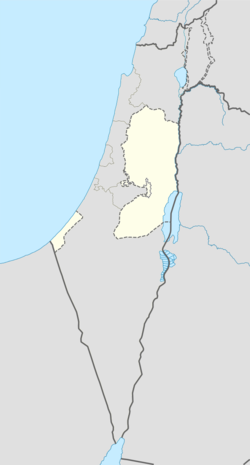History
Pottery sherds from the Middle Bronze Age, Iron Age I and IA II, Persian, Hellenistic, Roman, Byzantine and Crusader/Ayyubid have been found here. [4]
It was populated by Samaritans up until the Arab conquest, and probably later into the Umayyad period. [5]
An Ayyubid text in the village mosque, first noted in situ by D.C. Bamraki, dates it to 1210 CE. [6] [7]
Pottery sherds from the Mamluk era have also been found here. [4] The village is seem to be the birthplace of the Muslim scholar Abdullah al-Farkhawi (d. 1415). [8]
Ottoman era
In 1517 the village was included in the Ottoman empire with the rest of Palestine, and in the 1596 tax-records it appeared as Farha, located in the Nahiya of Jabal Quba, part of Nablus Sanjak. The population was 17 households, all Muslim. They paid a fixed tax rate of 33.3% on agricultural products, such as wheat, barley, summer crops, olive trees, goats and beehives, in addition to occasional revenues and a fixed tax for people of Nablus area; a total of 2,800 akçe. [9] Pottery sherds from the early Ottoman era has also been found here. [4]
In the 18th and 19th centuries the village formed part of the highland region known as Jūrat ‘Amra or Bilād Jammā‘īn. Situated between Dayr Ghassāna in the south and the present Route 5 in the north, and between Majdal Yābā in the west and Jammā‘īn, Mardā and Kifl Ḥāris in the east, this area served, according to historian Roy Marom, "as a buffer zone between the political-economic-social units of the Jerusalem and the Nablus regions. On the political level, it suffered from instability due to the migration of the Bedouin tribes and the constant competition among local clans for the right to collect taxes on behalf of the Ottoman authorities." [10]
In 1838 Furkha was noted as village in the Jurat Merda area, south of Nablus. [11]
In 1870 Victor Guérin on his travels noted Farkha as a "considerable" village, located on a mountain peak. [12]
In 1870/1871 (1288 AH) an Ottoman census listed the village with a population of 36 households in the nahiya (sub-district) of Jamma'in al-Awwal, subordinate to Nablus. [13]
In 1882 the PEF's Survey of Western Palestine described Furkhah as: "An ancient village in a very strong position on a steep hill-top. The houses are of stone, and there are three sacred tombs, including Haram en Neby Shit, on the south. The fountain of Ain Yambua, in the valley, gives a supply of fine water, and there are two other springs east of the village. The place is evidently an ancient site. The hills around it are very steep and rocky." [14]
British Mandate era
In the 1922 census of Palestine conducted by the British Mandate authorities, Farkha had a population of 210 Muslims, [15] increasing in the 1931 census to 304 Muslims in 54 occupied houses. [16]
Tawfiq Canaan mention the custom of Mafazeh at the top of the ascent of Farkah; "a traveller after climbing a high mountain raises a heap of stones, or throw a stone on an existing heap, saying at the same time prayer as a mark of thanks to God that he has overcome a difficulty." [17]
In the 1945 statistics the population was 380 Muslims [18] while the total land area was 5,675 dunams, according to an official land and population survey. [19] Of this, 1,753 were allocated for plantations and irrigable land, 1,301 for cereals, [20] while 14 dunams were classified as built-up areas. [21]
This page is based on this
Wikipedia article Text is available under the
CC BY-SA 4.0 license; additional terms may apply.
Images, videos and audio are available under their respective licenses.

